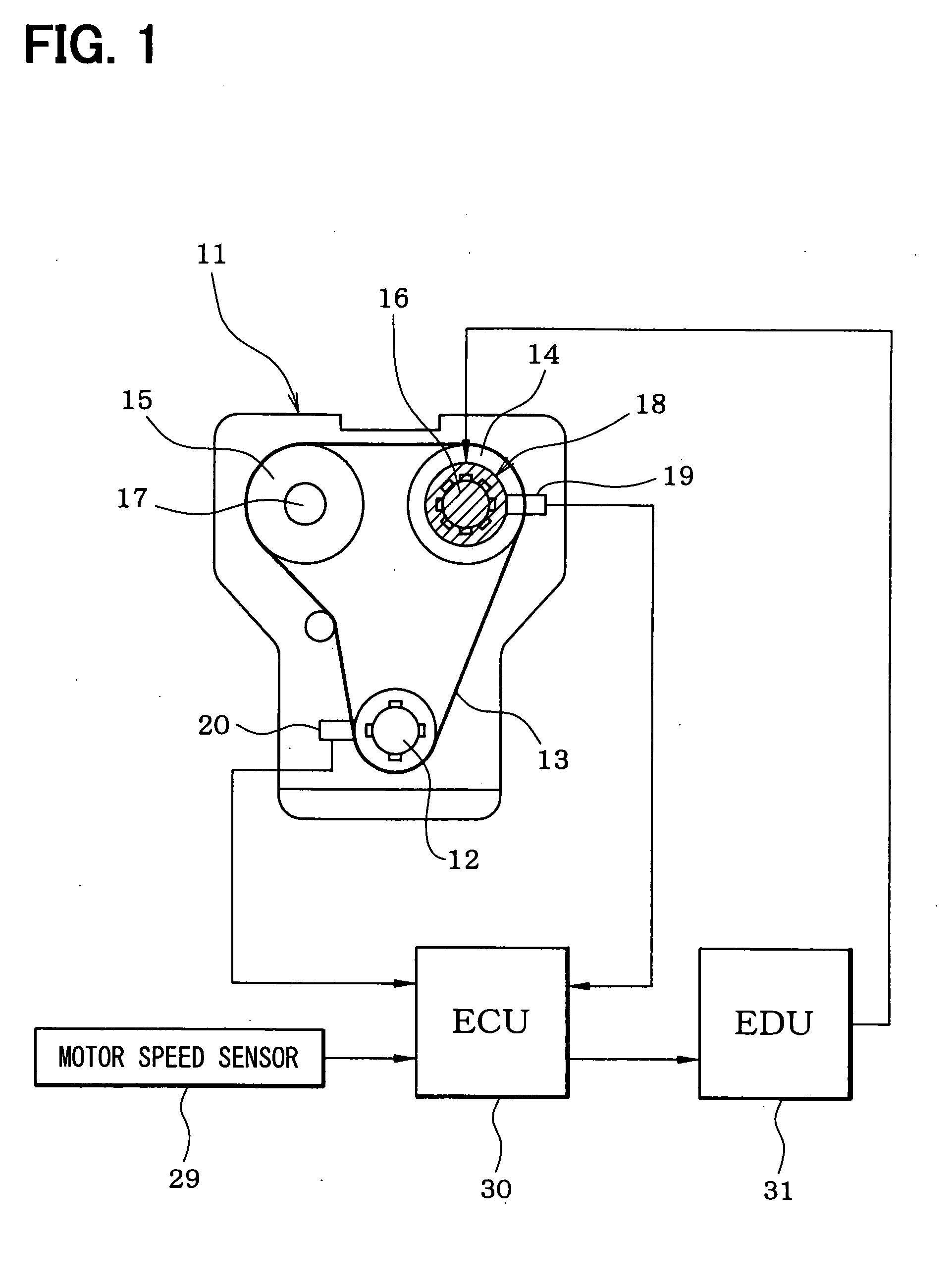Variable valve timing controller for internal combustion engine
a timing controller and variable valve technology, applied in the direction of valve drives, machines/engines, couplings, etc., can solve the problem of slow response speed of the variable valve timing control, and achieve the effect of preventing motor failure and deteriorating durability
- Summary
- Abstract
- Description
- Claims
- Application Information
AI Technical Summary
Benefits of technology
Problems solved by technology
Method used
Image
Examples
first embodiment
[0021] Referring to FIGS. 1 to 9, a first embodiment 1 of the present invention is described hereinafter.
[0022]FIG. 1 schematically shows a whole structure of an engine control system. An internal combustion engine 11, which is referred to as an engine hereinafter, includes a crankshaft 12. A driving force of the crankshaft 12 is transmitted to an intake camshaft 16 and an exhaust camshaft 17 through a timing chain 13 (or a timing belt) and sprockets 14, 15. A variable valve timing controller 18, which includes an electric motor, is coupled to the intake cam shaft 16. The variable valve timing controller 18 varies a rotational phase (camshaft phase) of the intake camshaft 16 relative to the crankshaft 12 so that the valve timing of an intake vale (not shown) is adjusted.
[0023] A cam angle sensor 19 is provided around the intake camshaft 16. The cam angle sensor 19 outputs a cam angle signal every predetermined cam angle of the intake camshaft 16. A crank angle sensor 20 is provide...
second embodiment
[0054] In a second embodiment shown in FIGS. 10 and 11, the duty of the voltage applied to motor 26 is estimated as the information of the motor current, and when the estimated duty exceeds the predetermined value, the variation (motor speed F / B correction amount) in the target motor speed which is outputted to the EDU31 from the ECU30 is restricted, whereby the motor current is restricted. Hereafter, the processing of each program shown in FIGS. 10 and 11 is explained.
[0055] In the target motor speed computation program shown in FIG. 10, processings except steps 103a and 104a are the same as those shown in FIG. 4
[0056] After computing the camshaft phase deviation and the rotational speed F / B correction amount in steps 101 and 102, the procedure proceeds to step 103a in which a duty estimation program shown in FIG. 11 is executed. In step 103a, a duty ratio is estimated based on the instant target motor speed and the instant actual motor speed. Then, the procedure proceeds to step ...
third embodiment
[0062] In first and second embodiments, when the estimated motor current (duty) exceeded the specified value, the motor current is restricted. In a third embodiment shown in FIG. 12, when the estimated motor current (duty) exceeds the specified value, the motor current is intercepted in step 105a and the diagnosis of the variable valve timing controller 18 is stopped in step 106a. The other processings are the same as the first embodiment.
[0063] According to the third embodiment, when the estimated current (duty) exceeds the specified value, the motor current is intercepted to decrease coil temperature of the motor 26. Furthermore, since the diagnosis of variable valve timing controller 18 is stopped, it can prevent an erroneous decision that the state where the variable valve timing control is compulsorily stopped by interception of the motor current is determined as malfunction.
[0064] Besides, the present invention is not limited to the variable valve timing controller of the in...
PUM
 Login to View More
Login to View More Abstract
Description
Claims
Application Information
 Login to View More
Login to View More - R&D
- Intellectual Property
- Life Sciences
- Materials
- Tech Scout
- Unparalleled Data Quality
- Higher Quality Content
- 60% Fewer Hallucinations
Browse by: Latest US Patents, China's latest patents, Technical Efficacy Thesaurus, Application Domain, Technology Topic, Popular Technical Reports.
© 2025 PatSnap. All rights reserved.Legal|Privacy policy|Modern Slavery Act Transparency Statement|Sitemap|About US| Contact US: help@patsnap.com



